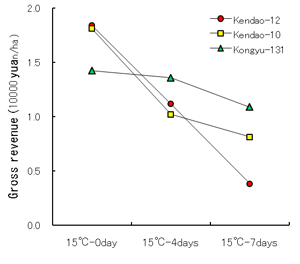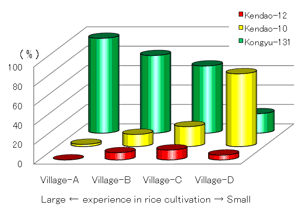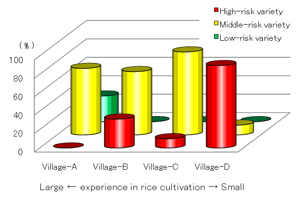Risk management of rice farmers against cool summer damage in Heilongjiang Province, China
Description
Heilongjiang Province has the largest share of rice production in China. However, because of the relatively short history of rice cultivation in the area, a lot of farmers do not fully realize the impact of chilling injury or cold damage to their farm management operations. And, they believe that the risk of chilling injury does not threaten their own farming operations, with the average temperature rising because of global warming.
Based on the above, in order to clarify the risk attitude of rice farmers to chilling injury, four villages in Hulin City, which suffered huge cool summer damage due to floral impotency in 2002, were studied five years after in 2007 as to their rice varieties selection and cultivation practices (sample number: 163).The total yield of rice in Hulin City declined to 46.5% in 2002 as compared with the previous year, and this exceeded the decline rate of the hard-hit areas of the whole province in 1969, 1971, 1976 and 1981. However, from the statistics at the provincial level in 2002, we were unable to determine the severity of the cold damage. This is largely due to the recent expansion in the area of paddy fields throughout the province , the delayed growth of technological advances and the transformation of the type of cool summer damage from being a regional damage due to delayed growth into localized damage due to floral impotency.
It is difficult to implement deep water irrigation and cold damage countermeasure in Heilongjiang Province because of its severe water limitations. Thus, planting rice varieties with cold resistance is currently the effective countermeasure as risk control against cold weather damage. Through a Cold Tolerance Test conducted at the flowering stage on the three main varieties with large cultivation areas in Hulin City (Kendao-12, Kendao-10, Kongyu-131), it showed that among the three varieties, Kendao-12 and Kendao-10 yielded higher profitability in the year under normal weather but their yield earnings dropped in low temperatures (Fig. 1).
Because of the declining rate of the cultivated area of the Kongyu-131, its yield was smaller when the chilling injury occurred in 2002; but beginning from the second year, there was a significant increase. However, only 7.4 percent of farmers surveyed planted Kongyu-131 in 2007. In addition, in answer to the most important factor when selecting varieties, only 3% of the farmers answered “cold resistance”, 39% answered "yieldability" and 30% answered "disease resistance"; hence, the gap is very obvious.
When showing Fig.1 to surveyed farmers, wherein variety names were replaced by code names and farmers selected their most desirable varieties, it showed that with a shorter history of planting rice for farmers, they were more inclined to select the varieties with higher risk even in areas severely affected at that time with the cold weather damage (Fig. 2). Under such condition wherein farmers failed to grasp the cold resistance of rice varieties, the decline in yield for the actual planted varieties, as compared with Fig.2, was greater in the presence of cold damage (Fig. 3).
Rice farmers’ vigilance towards reducing the risk of cold damage is weakening over time in Hulin City, Heilongjiang Province. In order to reduce the threat in rice production, risk management is an important factor and risk communication for effective damage control must be especially targeted as prioritized assistance to farmers lacking experience in rice cultivation.
Figure, table
-
Fig. 1. Varietal differences in the Cold Tolerance test -
Fig. 2 Rice varieties which farmers intended to plant -
Fig. 3 Rice varieties which farmers actually planted -
- Affiliation
-
Development Research Division
- Classification
-
Technical B
- Term of research
-
FY2008(FY2004~2008)
- Responsible researcher
-
NAKAMOTO Kazuo ( Development Research Division )
JIAO Jiang ( Heilongjiang Provincial Academy of Agricultural Sciences )
Li Ninghui ( Institute of Agricultural Economics and Development, CAAS, China )
- ほか
- Publication, etc.
-
Nakamoto et al. (2008) Risk Management and Farming Planning for Sustainable Farming Management.JIRCAS working report No.59、51-71.
Nakamoto et al. (2007) 黑龙江水稻生产与风险经营.中国农业科学技术出版社.
- Japanese PDF
-
2008_seikajouhou_A4_ja_Part4.pdf574.82 KB



